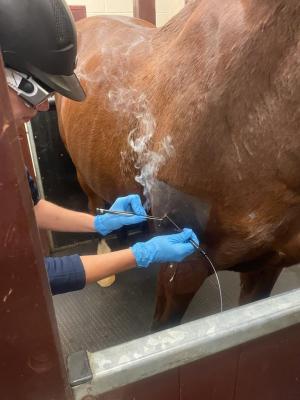Equine Therapy for Children: Psychological and Behavior Support Described
Equine Therapy for Children: Psychological and Behavior Support Described
Blog Article
Laser Therapy in Equine Treatment: A Modern Technique to Improving Steed Wellness
Laser treatment has arised as a crucial technique in equine therapy, utilizing focused light energy to foster mobile fixing and expedite recuperation from a range of disorders. This non-invasive technique is particularly reliable in handling bone and joint injuries, wounds, and inflammatory problems, substantially improving total steed health and wellness. By boosting mitochondrial activity and enhancing ATP manufacturing, laser therapy not just improves flow but also gives considerable discomfort relief. As this ingenious treatment continues to gain grip, it opens interesting possibilities for dealing with persistent conditions like joint inflammation and unguis issues, indicating a transformative change in veterinary treatment. What makes this modality particularly engaging?
Recognizing Laser Treatment
Laser treatment, a non-invasive treatment method, has actually obtained significant traction in equine medicine due to its efficiency in advertising recovery and pain alleviation. Enhanced ATP levels speed up tissue fixing procedures and decrease swelling, making laser therapy especially efficient for treating bone and joint injuries, injuries, and various other inflammatory conditions in equines.
There are numerous kinds of lasers utilized in equine therapy, each with particular wavelengths and power results customized to different restorative needs. Low-level laser therapy (LLLT), likewise called cold laser therapy, employs lower power levels to stimulate cell function without causing thermal damage. High-intensity laser treatment (HANDLE), on the other hand, uses higher power degrees to attain much deeper tissue penetration and more considerable healing results.
Veterinarians use different laser tools and techniques depending upon the condition being treated and the preferred depth of tissue penetration. Proper training and expertise are vital for guaranteeing the secure and reliable application of laser treatment, thus maximizing its restorative capacity while reducing risks.
Advantages for Equine Health
With a solid understanding of how laser therapy works, it is important to discover its many advantages for equine health and wellness. By stimulating mobile function, laser therapy advertises faster injury healing and aids in the regrowth of damaged tissues.
In addition, laser therapy has actually been revealed to boost flow, thereby improving blood circulation to impacted locations. Boosted circulation guarantees that essential nutrients and oxygen are delivered a lot more efficiently, assisting in the recovery process. In addition, laser therapy's anti-inflammatory impacts assist in minimizing swelling and pain, which is critical for the general health of the equine.
Pain management is another substantial benefit. By releasing endorphins and obstructing discomfort signals, laser treatment offers efficient, non-invasive remedy for both intense and chronic discomfort. This can contribute to improved wheelchair and lifestyle for the pet.
Lastly, laser find out therapy is a non-invasive treatment alternative, minimizing the threat of difficulties related to even more intrusive treatments. Its flexibility and effectiveness make it an invaluable device in contemporary equine vet medication.
Typical Problems Treated

An additional widespread problem treated with laser therapy is joint inflammation. Furthermore, laser therapy is utilized in the monitoring of injuries.
Horse breathing conditions, such as persistent airway obstruction (RAO), additionally react positively to laser therapy. The anti-inflammatory residential properties of the therapy help in reducing respiratory tract inflammation, thus boosting breathing function. Moreover, why not look here laser treatment is helpful in treating hoof troubles, including laminitis and abscesses. By improving circulation and minimizing pain, it sustains quicker recuperation.
Treatment and Security
Implementing laser treatment in equine treatment includes a thorough procedure to make sure both efficiency and safety and security. Equine Therapy. The process starts with a complete vet assessment to figure out the viability of laser treatment for the horse's specific problem. Once considered proper, the therapy area is prepared by cleaning and, if needed, clipping the hair to improve laser penetration
The practitioner needs to pick the right type of laser, generally a low-level laser (LLLT) or a high-power laser (HPL), relying on the condition being dealt with. The laser tool is after that calibrated to the suitable wavelength, power, and duration setups. During the application, the practitioner relocates the laser over the targeted area in an organized way, making certain consistent and even direct exposure.
Safety and security protocols are purely followed, including making use of safety glasses for both the professional and the equine. In addition, it is critical to monitor the steed for any type of signs of discomfort or adverse reactions throughout the procedure. Post-treatment, the steed is typically given a period of rest to permit the therapeutic impacts to manifest.

Future of Horse Laser Treatment
As advancements in veterinary medication continue to unravel, the future of equine laser treatment holds considerable pledge. Emerging technologies and much deeper scientific understandings are set to refine and increase the applications of laser treatment for steeds.
Moreover, ongoing research right into the molecular and mobile systems of laser treatment will likely generate enhanced protocols tailored to certain conditions, improving performance and minimizing treatment times. Customized treatment strategies based upon hereditary and biochemical markers can come true, guaranteeing that each equine receives one of the most appropriate and reliable treatment.
Furthermore, regulative innovations and standardization of methods will boost the trustworthiness and integrity of laser treatment in equine technique. Equine Therapy. As these technologies remain to emerge, equine laser therapy is positioned to come to be a vital component of vet treatment, offering enhanced healing and improved high quality of life for horses globally
Final Thought
Report this page